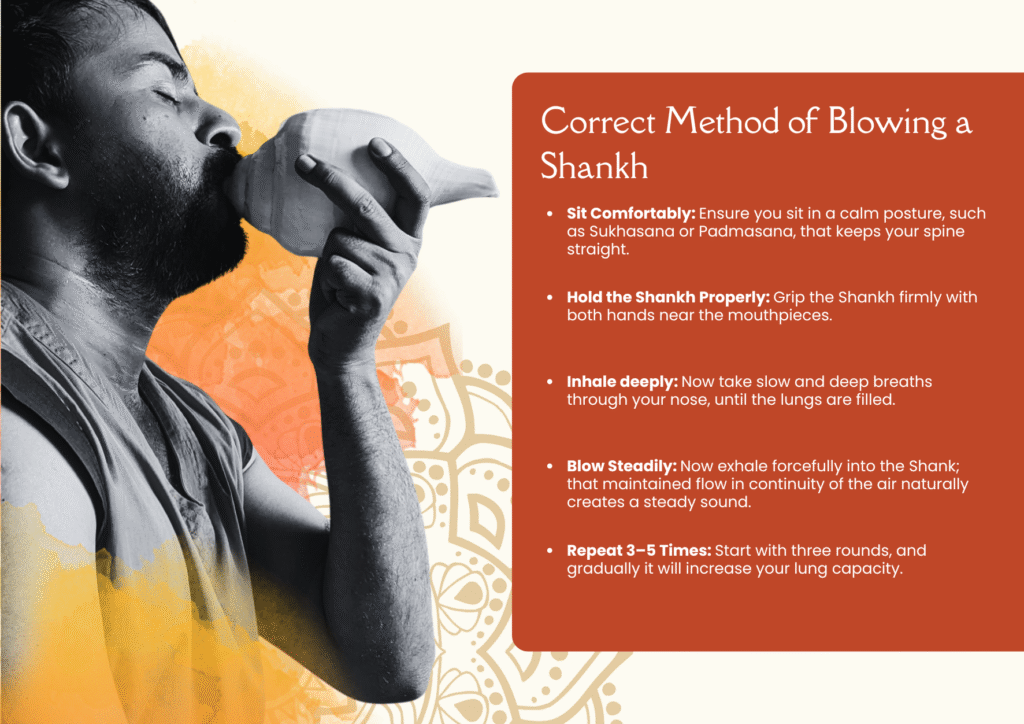
Can Daily Shankh Blowing Practice Help Manage Anxiety & Stress?
The ancient Indian traditions hold deep meaning and significance in the Shankh. In fact, blowing off the conch shell is not merely a ritual performed during pujas or temple ceremonies. It’s a form of breath exercise—Pranayama, that helps in controlled breathing techniques, which supports physical and mental wellness. Meanwhile, modern wellness freaks are rediscovering the ancient practice, which gives incredible benefits on stress relief, mental clarity and emotional balance.
The Science Behind Shankh Blowing
Shankh blowing practice online involves the deep inhalation and controlled exhalation through the mouth, which is similar to regular breathing in Pranayama. Its rhythmic breathing supports oxygenating the body, strengthening the lungs and calming the nervous system. Blowing of the Shankh correctly activates the parasympathetic nervous system, which is responsible for relaxation and emotional stability.
The sound vibrations also resonate through the chest and abdomen—that gently massages internal organs such as lungs, diaphragm and heart. This promotes better oxygen flow and reduces stress-induced tension. Over time, with consistent practice, it even lowers the cortisol level (the hormone linked with stress and anxiety).

Correct Method of Blowing a Shankh
If you practising the correct method of blowing the Shankh, then follow the steps;
- Sit Comfortably: Ensure you sit in a calm posture, such as Sukhasana or Padmasana, that keeps your spine straight.
- Hold the Shankh Properly: Grip the Shankh firmly with both hands near the mouthpieces.
- Inhale deeply: Now take slow and deep breaths through your nose, until the lungs are filled.
- Blow Steadily: Now exhale forcefully into the Shank; that maintained flow in continuity of the air naturally creates a steady sound.
- Repeat 3–5 Times: Start with three rounds, and gradually it will increase your lung capacity.
Shankh Benefits for the Mind & Body
Eventually, the Shankh Benefits apart from blowing go beyond religious significance. But when practised regularly, it works as a natural therapy for the mind and body.
Reduces Stress and Anxiety
The steady sound and vibration of the Shankh help regulate breathing, calm the mind, and bring the body into a relaxed state. This lowers the heart rate and promotes the release of endorphins—your body’s natural mood lifters.
Improves Lung Capacity
Shankh blowing requires controlled exhalation. It strengthens the respiratory system—improves oxygen intake and endurance. This helps people with mild respiratory issues to build stamina.
Boosts Concentration and Mental Clarity
The vibrations and sound frequencies help declutter the mind and improve the ability to focus. Regular practice of Shankh Pranayama improves mental clarity, emotional balance and focus.
Enhances Energy Flow
The sound of the Shankh activates positive energy channels, nadis. It helps clear the energetic blockages. Thus, it promotes inner balance as it harmonises physical and mental strength.
Strengthens Vocal Cords and Throat
The energy and vibrations generated during the Shankh blowing ritual do stimulate the throat muscles. It even improves voice quality and clears mucus from the respiratory passages.
Purifies the Environment
The original Shankh Sound is associated with emitting negative frequencies and energies in the surroundings. This reason is enough for blowing a conch shell as a ritual to purify the space and deliver positivity.
The Importance of Shankh at Home
Keeping or blowing hits different importance of Shankh at home attracts prosperity, peace and positivity. Traditionally, in homes, Shankh blowing is done during sunrise and sunset, which is believed to drive away negativity. It even improves the household’s vibrational frequency.
Whether it’s from a wellness perspective, the Shankh is a beautiful reminder to the mind and body to calm and relax. This even supports mindful acts, which aligns the ability to focus, lowers daily stress levels and promotes a sense of gratitude.
For those who may not blow the Shankh regularly, simply keeping it in the northeast direction (Ishaan corner) of your home is considered auspicious. It symbolises clarity, purity, and protection.
Integrating Shankh Practice into Your Routine
A small start of a few minutes a day makes a noticeable difference. Here’s how you can add Shankh Pranayama to your wellness practice:
- Begin early in the morning on an empty stomach.
- Sit in a quiet, open space with minimal distractions.
- Focus on your breathing before blowing the Shankh.
- Combine it with meditation or chanting for enhanced mindfulness.
- End the session with a few minutes of silence to absorb the vibrations.
The Connection Between Sound & Emotional Healing
The average sound frequency of the Shankh aligns with natural vibrations found in nature, such as deep oceanic waves or wind. It does trigger the brain’s relaxation response and helps reduce anxiety and quiet racing thoughts. It creates healing vibrations that balance emotional energy & stabilise mood swings. That reconnects the body and mind through breath & sound.
Spiritual and Symbolic Value
Indian spirituality represents Shankh as purest, prosperous and auspicious beginnings. This is closely associated with Lord Vishnu, symbolising creation and the primordial sound of Om. Blowing of Shankh is believed to attract divine energies and repel negativities—both internally and externally. Apart from this, it even helps in interpreting as a reminder to breathe deeply, let go of negativity, and embrace the feeling of calmness.
The Final Verdict
If you are into daily Shankh practice, then it becomes easy to blow Shank but impact the mind and body with a sense of relaxation, mindfulness and calmness. It helps in managing anxiety, stress and emotional imbalance. The deep sound vibrations give physical and subtle energy levels, improving breathing patterns. It even enhances mental focus & promotes. By blending ancient wisdom with modern mindfulness, this age-old ritual offers a holistic, natural approach to emotional and physical wellness.
FAQs
1. How long should I practice Shankh blowing daily?
Start with 3–5 rounds per session and gradually increase the duration as your lung capacity improves. Consistency is more important than intensity.
2. Can anyone practice Shankh blowing?
Yes, almost anyone can practice it, but those with respiratory issues, high blood pressure, or hernia should consult a yoga expert or doctor before starting.
3. What is the best time to blow the Shankh?
Morning and evening are ideal times that are Brahma Muhurta (4:30am) to Sandhya Aarti (7:45pm) as the mind and environment are calm. It also aligns with traditional practice times that enhance the Shankh’s positive vibrations.
Explore insights from Kalari Warriors, blending ancient Kalaripayattu traditions with spiritual craftsmanship to enrich your life and rituals.




